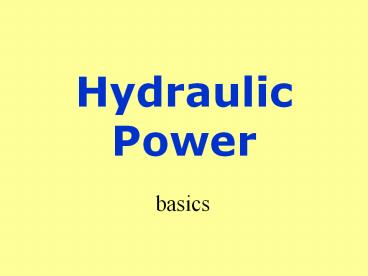Hydraulic Power - PowerPoint PPT Presentation
Title:
Hydraulic Power
Description:
Hydraulic Power basics Pascal s Law Hydraulic Terms Hydraulic Pneumatic PSI Input / Output Pump Piston Pumps Work well at PSI s of 2000 or more Single piston pump ... – PowerPoint PPT presentation
Number of Views:4617
Avg rating:3.0/5.0
Title: Hydraulic Power
1
Hydraulic Power
- basics
2
Pascals Law
Pressure exerted at any point on a confined
liquid is transmitted undiminished in all
directions.
3
Hydraulic Terms
Hydraulic Piston Shaft PSI
Pneumatic Stroke Check valve Spool valve
Pump Seal Rockshaft Cylinder
Hydraulic motor Single-acting Double-acting Input / Output
4
Hydraulic
Tool or equipment powered by the movement of
fluid under pressure. Examples are brakes, jacks
tractor lifts.
5
Pneumatic
Tool or equipment powered or supported by the
movement of compressed air.
6
PSI
Pounds per Square Inch determines amount of force
GPM
Gallons per Minute determines speed of action
7
Basic principle
Pressure applied to piston A is transferred
equally to a piston of the same size B because
PSI is the same throughout the system.
8
hydraulic advantage
If the surface area of piston B is 10 times the
surface area of piston A, then the force
applied to piston A is multiplied 10 times as
the force exerted on piston B. PSI is equal
throughout the system.
9
Input / Output
Force input on a hydraulic system or component
results in transfer of power to output of force
by the system or component.
10
Pump
Functions in a hydraulic system by pressurizing
and moving fluid from one part of the system to
another.
11
Hydraulic pumps are usually one of four
typesPISTONGEARVANEINTERNAL ROTOR
12
Piston Pumps
- Work well at PSIs of 2000 or more
- Single piston pump used in bottle jacks
- Require several pistons working together to
generate enough volume for tractor applications - Necessarily involve many moving parts
13
Gear Pumps
- Work well at 1500 PSI and below
- Work with a minimum of moving parts
- Less expensive to manufacture than piston type
pumps
14
Gear Pump
driven gear
idler gear
15
Hydraulic Motor
Receives power from moving fluid to transfer
hydraulic power to mechanical rotating force.
16
Cylinder
Piece of equipment that transfers hydraulic power
into mechanical movement in one or two directions
only.
17
Hydraulic Cylinder
18
Single-acting
Refers to a hydraulic cylinder that works in one
direction only.
Double-acting
Refers to a hydraulic cylinder that pushes and
pulls.
19
Single-acting cylinder
20
Double-acting Cylinder
21
Piston
Internal component of a hydraulic cylinder that
is moved in a linear motion by the action of
fluid introduced into the cylinder.
22
Shaft
The polished round bar that is extended from and
retracted into a hydraulic cylinder.
23
Stroke
The length of movement that a hydraulic cylinder
is capable of producing.
24
Seal
Found in hydraulic components function is to
keep fluid from leaking between moving and
non-moving parts
25
Check Valve
Restricts flow of fluid to only one direction
allows pressure to build up or be maintained.
26
Spool Valve
Controls direction of flow of fluid in a
hydraulic system to cause the different parts of
the system to function.
27
(No Transcript)
28
(No Transcript)
29
The first hydraulic power lift for a tractor was
introduced in 1935 by John Deere. This unit only
had two positions, up and down, but the hydraulic
action cushioned the lowering of the implement.
30
Rockshaft
Rotating shaft on a modern tractor powered by an
internal hydraulic cylinder used to transfer
power to the implement lift.































